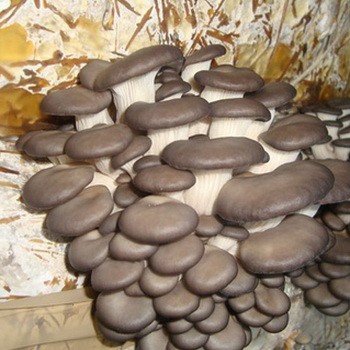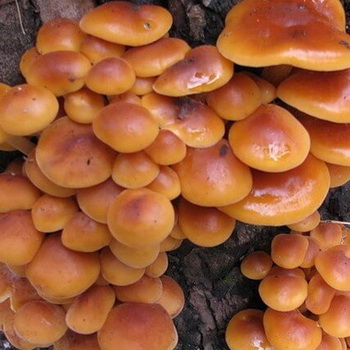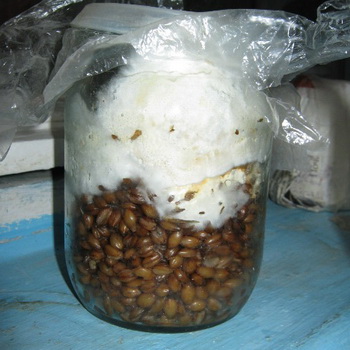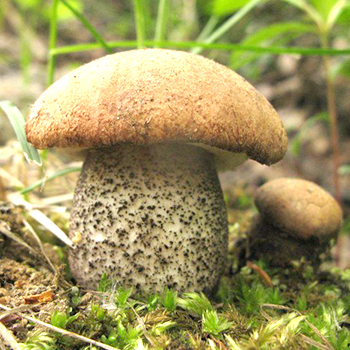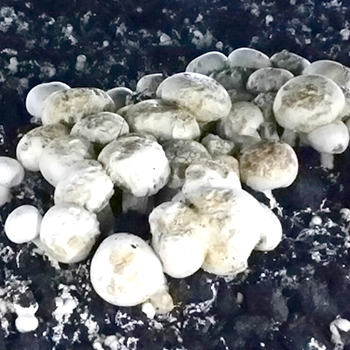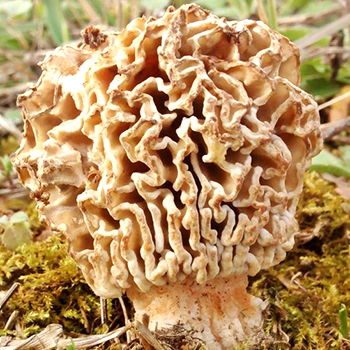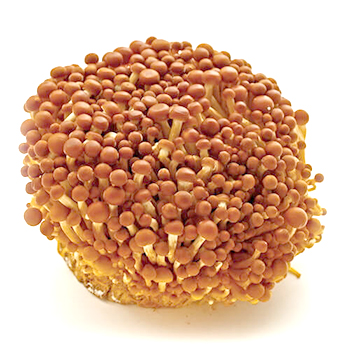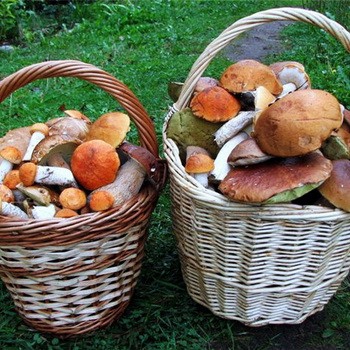Cereal mycelium and substrate for growing mushrooms

Content
- Storage of oyster mushrooms, mushrooms and other mushrooms in the refrigerator
- Reproduction of oyster mushroom mycelium and other mushrooms at home
- Substrate for growing oyster mushrooms and other mushrooms
- Processing when preparing a substrate for mushrooms at home
- Processing the substrate of oyster mushrooms and other mushrooms in the garden
- Substrate preparation for oyster mushrooms and other mushrooms: sterilization
Storage of oyster mushrooms, mushrooms and other mushrooms in the refrigerator
Currently under cultivation champignon, oyster mushrooms and shiitake mainly vegetative sowing is used with the help of the so-called sterile grain mycelium. It is a boiled and sterilized grain, mastered cleared from competitors mushroom cultivated mushroom. Non-sterile grain mycelium for growing mushrooms at home is not used, because in non-sterile conditions, the grain is quickly affected by putrefactive bacteria and mold. Cereal mycelium is suitable for the reproduction of most mushrooms. On the grain of wheat, barley and millet produce oyster mushroom mycelium and shiitake, on the grain of wheat and rye - mycelium of champignon and donut. Cereal mycelium for growing mushrooms has a good supply of nutrients. The mycelium produced by a large company, as a rule, guarantees the successful cultivation of the mushroom that is indicated on the package.
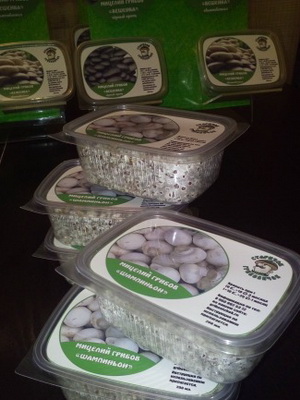

Cereal mycelium is sold in plastic bags with an air filter containing 8 kg of mycelium. The filter is needed for oxygen and to protect the mycelium from molds and from other competitors. With improper storage, the mycelium of champignons and most other fungi dies when the air temperature rises above 30 ° C. And at a negative storage temperature, the mycelium freezes and loses quality.
Long-term storage of mycelium for oyster mushrooms and other mushrooms is permissible at an air temperature of +2 ° C. Packages must be packed at intervals, as the mycelium is heated as a result of its own life. At home, storage of grain mycelium is possible in a domestic refrigerator, but not in a freezer. It should be borne in mind that, in modern household refrigerators, storage of mycelium, although permissible, should be borne in mind that in a chamber with automatic defrosting, the temperature periodically varies from +1 to +10 ° С. Therefore, with a long shelf life of oyster mushroom mycelium and shiitake, a hard crust of mycelium and the beginnings of fruiting bodies are formed inside the package, and mycelium of champignon and annulus quickly deteriorates.
When buying mycelium in small packages, you need to make sure that there is an air filter or holes in the air bag. Without this, the mycelium will quickly decay, and with holes without a filter, sooner or later it will catch mold.
Even if you have complied with all storage conditions of mycelium of mushrooms, before planting, you need to check its quality. You can do this in the following way. Prepare a solution from a teaspoon of sugar in a glass of boiled water. Fold the toilet paper in several layers with a 5x5 cm square. Clean toilet paper is sterile, unlike wipes. Moisten a paper square with sugar solution, wring it out and place in a Petri dish or on a clean saucer. Place a few grains of grain mycelium from the bag you bought and cover with a lid of a Petri dish or a glass. At room temperature, a week later, on a grain or on another substrate sold to you as a mycelium, a white fringe should appear from the mycelium growing in the air. There should be no color spots. This sprouted mycelium and a few months later should not have mold spots. So you can check not only the grain, but also any other mycelium.
Reproduction of oyster mushroom mycelium and other mushrooms at home
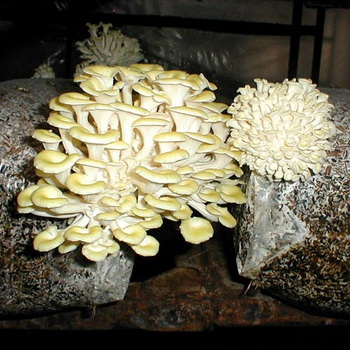 Purchased high-quality mycelium can be propagated independently. To multiply the mycelium of mushrooms, wheat grain must be boiled over low heat for 20-25 minutes. It must not be digested. It is important that the core of the grain remains white. Then the grain must be dried on the table, stirring it with a spatula for 30 minutes. Can be dried under a fan. After that, it should have a humidity of 50-53%. For drying, chalk and gypsum can be added to the grain - 5% by weight of the grain. Thus prepared grain is poured into two-liter glass jars at the rate of 1 kg per jar. Grain during the reproduction of oyster mushroom mycelium at home should occupy less than half the volume of the jar. Cans with grain tightly closed with lids with a stopper made of sterile cotton wool and sterilized with grain in a pot of boiling water or in an autoclave. A hole with a diameter of 3 cm is made for the cork in the center of the lid. To prevent boiling water from wetting the cotton plug, wrap the lids with aluminum foil or kraft paper, which is tied around the neck of the jar with string. Cut off excess paper edges.
Purchased high-quality mycelium can be propagated independently. To multiply the mycelium of mushrooms, wheat grain must be boiled over low heat for 20-25 minutes. It must not be digested. It is important that the core of the grain remains white. Then the grain must be dried on the table, stirring it with a spatula for 30 minutes. Can be dried under a fan. After that, it should have a humidity of 50-53%. For drying, chalk and gypsum can be added to the grain - 5% by weight of the grain. Thus prepared grain is poured into two-liter glass jars at the rate of 1 kg per jar. Grain during the reproduction of oyster mushroom mycelium at home should occupy less than half the volume of the jar. Cans with grain tightly closed with lids with a stopper made of sterile cotton wool and sterilized with grain in a pot of boiling water or in an autoclave. A hole with a diameter of 3 cm is made for the cork in the center of the lid. To prevent boiling water from wetting the cotton plug, wrap the lids with aluminum foil or kraft paper, which is tied around the neck of the jar with string. Cut off excess paper edges.
When propagating mycelium, put a rag under the cans and pour cold water 3-4 cm below the lids. To sterilize the grain, the jars must be boiled twice for 2 hours at intervals of one day. In the interval between boiling cans should be at room temperature. When using an autoclave at a temperature of +120 ° C and an overpressure of 1.0 atm. it is enough to sterilize once for 2.5 hours. Sterilization in a domestic autoclave at +110 ° C is acceptable.
Without removing the lids, the jars of grain must be cooled to + 22 ... + 55 ° C and transferred to a sterile box or other clean room for sowing grain with the sterile mycelium at your disposal. During seeding (inoculation), the lid with the filter must be removed, put a tablespoon of mycelium in the jar and again closed with a lid with a cotton stopper, then with kraft paper and tie. Then the jars must be shaken to evenly mix the mycelium with the grain and put in a clean room with an air temperature of + 24 ... + 26 ° C for overgrowing.
The incubation time in the jar with grain is 14 days for the reproduction of oyster mushroom mycelium, and more than 30 days for shiitake. The duration of incubation of other fungi takes the same period. After 7 days of growing mycelium, the contents of the cans should be shaken so that the grain is not too tightly bound by mycelium, and grain overgrowing is uniform.
After the grain in the banks is completely overgrown, you can transfer the mycelium from the cans into plastic bags.
Substrate for growing oyster mushrooms and other mushrooms
Good yields of oyster mushrooms, shiitake and other tree mushrooms can be grown on a loose substrate made from shredded straw, cotton tow, husk of sunflower seeds or ground branches. Nutrient additives can be added to such a substrate for growing mushrooms, and heat treatment of the substrate will free it from mold.The granular structure provides oxygen access to the developing mycelium, therefore the development of such a substrate occurs several times faster than the development of dense wood. To create a high concentration of carbon dioxide, necessary for the growth of mycelium, the substrate at home is placed in plastic bags with air-permeable plugs or with perforation.
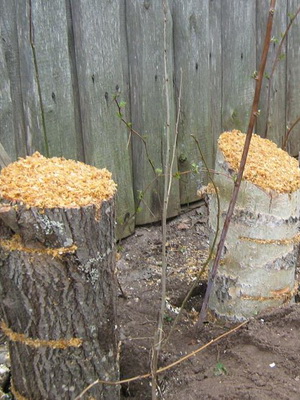
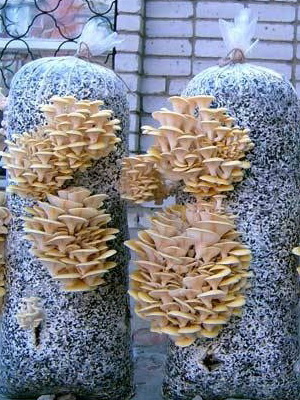
The basis of the substrate is called the material, comprising more than 50% of its total mass. The nitrogen content in the basic materials of the substrate is as follows: sawdust - 0.1%, flax bonfire - 0.5%, straw - 0.6%, husk - 0.7%, cotton tow - 0.7%, ground branches - 0 , 7% (all in relation to dry weight). To achieve the optimal nitrogen content (0.7-1.0%), the substrate for mushrooms can be made grain by adding grain or bran in the amount of 10-20% of the dry weight of the substrate. The substrate must be moistened so that its moisture content is in the range of 45 to 70%. The optimum moisture content of the substrate is 60%.
The moisture content of the substrate for fungi (W%) is the percentage ratio of the mass of water in it to the mass of the substrate. Humidity is determined as follows: 100 g of the substrate is kept in an oven or oven for 6 hours (to constant weight) at a temperature of + 110 ... + 120 ° C (not higher than 150 ° C to prevent carbonization of the dried components).
The difference between the weight of the wet and dry sample, expressed in grams, will be numerically equal to the moisture content of the substrate in percent. You can dry a 100 g sample in a microwave instead of an oven. The microwave oven is tuned to a level of 350-400 watts. Warming up mode: warming up 4 min; pause 2 min; warming up 4 min; pause 2 min; 4 min warm up
Mushrooms - aerobic organisms that consume atmospheric oxygen and emit carbon dioxide. Therefore, the main parameter of the substrate basis for fungal mycelium is its air permeability: the structure of the substrate must be loose, and the shell of the substrate block (plastic bag) must have an opening for the “breathing” of the mycelium. The permeability of the wet substrate for air decreases sharply with a decrease in the particle size of the substrate base and, especially, when the substrate is waterlogged, when zones filled with free water appear in it. The diffusion coefficient of oxygen in water is tens of thousands of times less than in air. Therefore, the overmoistening of the substrate for oyster mushrooms and other fungi creates anaerobic conditions in it, in which the mycelium cannot exist.
Processing when preparing a substrate for mushrooms at home
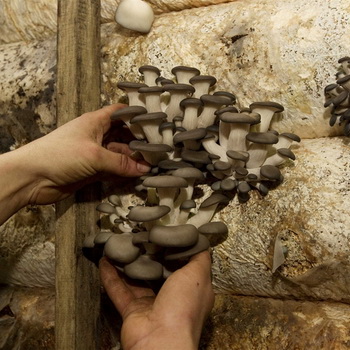 The best material for future substrate mycelium is small chips from milled fresh deciduous branches. If you cannot use all the prepared raw materials at once, you need to grind the branches and then dry at high temperature in the oven or in the oven. From 1000 g of fresh branches, 500-600 g of dry branches will turn out. Instead of ground branches, you can use shredded straw, flax fire or husk from sunflower seeds that was not exposed to rain. The next step is to prepare the right amount of clean three-liter cans. Make a 1-2 cm round hole in the plastic can lids. Wash the lids and cans thoroughly. Insert the sterile cotton plugs tightly (twisted pieces of cotton wool) into the holes in the caps. At the time of heat treatment of the cans, remove the caps with caps in a clean plastic bag.
The best material for future substrate mycelium is small chips from milled fresh deciduous branches. If you cannot use all the prepared raw materials at once, you need to grind the branches and then dry at high temperature in the oven or in the oven. From 1000 g of fresh branches, 500-600 g of dry branches will turn out. Instead of ground branches, you can use shredded straw, flax fire or husk from sunflower seeds that was not exposed to rain. The next step is to prepare the right amount of clean three-liter cans. Make a 1-2 cm round hole in the plastic can lids. Wash the lids and cans thoroughly. Insert the sterile cotton plugs tightly (twisted pieces of cotton wool) into the holes in the caps. At the time of heat treatment of the cans, remove the caps with caps in a clean plastic bag.
After preparing the substrate in the amount needed to fill one or more three-liter containers, transfer it to jars. Seal the substrate so that it does not reach the neck of a few centimeters. Pour boiling water into the substrate in the jar so that the jar does not burst. After absorption, add boiling water so that it completely covers the substrate. Close cans with lids with holes for draining water, but do not drain water immediately. Leave the jars with boiling water to cool slowly at room temperature for 2-3 hours. Turn the jars over, drain the water from them and leave them upside down for a day.During this time, water will merge from the cans, and not dead mold spores in the substrate will germinate and become defenseless against a repeated increase in temperature. This method is called fractional pasteurization of the substrate.
In the process of preparing the substrate at home, weigh each jar of moistened contents on the scales. For heat treatment of the substrate for oyster mushrooms and other mushrooms, close the jars with aluminum foil or a tin lid (leaking). Put the jars in any thermal furnace or in the oven for 3 hours at a temperature of 80 ° C.
Let the jar cool to room temperature and weigh it again. If the can with the substrate has lost more than 20% in weight during heat treatment, bring the mass of the can to 80% of the original by adding boiled water to the substrate. Remove the aluminum foil and close the jar with a clean polyethylene lid with a cotton plug. Now the substrate is ready for inoculation with its mycelium.
An easier way to heat the substrate is called xerothermic. The following is the preparation of a substrate soaked to the desired moisture content in the amount necessary to fill one or more three-liter cans. Put it in jars.
Seal the substrate so that it does not reach the neck - a few centimeters. Weigh the jars with the substrate. Put the cans in the oven, heated to 110 ° C for 2-4 hours, to boil all the water from the substrate, cool the cans and fill in the substrate with clean boiled water in such an amount as to restore the weight of the substrate that was before the heat treatment. Close the jar with a clean polyethylene lid with a cotton plug. Now the substrate is ready for inoculation with its mycelium.
Processing the substrate of oyster mushrooms and other mushrooms in the garden
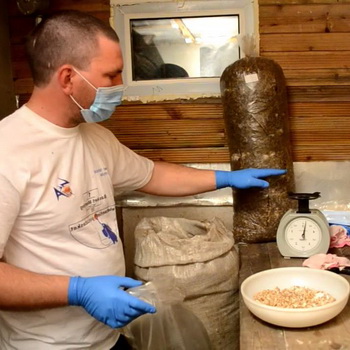 With a clean, mold-free raw material, pasteurization can be done only once. In the garden, you can pasteurize the substrate in a 200-liter barrel at the stake. Place the barrel on concrete blocks or bricks. Pour 50 liters of water into it. Above the water, on bricks placed vertically inside the barrel, insert a round (barrel-shaped) net or grid.
With a clean, mold-free raw material, pasteurization can be done only once. In the garden, you can pasteurize the substrate in a 200-liter barrel at the stake. Place the barrel on concrete blocks or bricks. Pour 50 liters of water into it. Above the water, on bricks placed vertically inside the barrel, insert a round (barrel-shaped) net or grid.
After preparing the substrate for the mushrooms of the desired composition and humidity, fill them with polypropylene bags, leaving part of the package empty for tying his throat with a rope. You can use "rustling" bags of low-pressure polyethylene. More elastic bags made of high-pressure polyethylene, which do not rustle, are not suitable for this. They will collapse upon boiling. More expensive bags designed to freeze foods are also suitable. Insert a piece of cotton or synthetic winterizer into the throat of the bag as a breathable cork. Pull the throat of the packet around the cork with twine. Put the substrate blocks in several tiers on the grid up the cork. Close the barrel with a lid and leave the barrel with the substrate for a day or more to grow mold spores in the substrate. The next day, light a fire under a barrel and boil water for 6 hours in a row. By the next morning, the substrate in the barrel will cool. To “inoculate” the substrate, untie the bag, remove the cork, check that the temperature of the substrate is below 30 ° C, add mycelium, then reinsert the cork and tighten the throat of the bag with twine.
When growing exotic mushrooms (shiitake, maitake), for greater reliability, double fractional pasteurization is necessary. The sequence of operations for double fractional pasteurization is as follows. Bags with a substrate soaked to the required humidity, closed with a synthetic winterizer or cotton plug, are kept at room temperature for 24 hours, then placed in a “Chinese barrel” on a fire, pasteurized at a temperature of + 80 ... + 100 ° С for 3-6 hours, depending on the volume of the bag. After that, they are left in the barrel to cool for 16-24 hours, then again a fire is made and a second pasteurization is carried out.
In the same way, pasteurization can be carried out in a sauna or in any other bath at + 80 ... + 90 ° С.
Substrate preparation for oyster mushrooms and other mushrooms: sterilization
The basis of any autoclave is a robust container with a lid that can withstand excessive pressure of water vapor inside and is equipped with a valve for bleeding steam in case of dangerous overpressure. It is believed that when preparing a substrate for oyster mushrooms and other mushrooms in an autoclave, complete sterility is achieved at +134 ° С - all organisms known on earth die. Microorganisms that can harm cultivated fungi die at +120 ° C. Industrial autoclaves intended for mushroom growing operate at an overpressure of 1 atm, which ensures the processing of the substrate at +120 ° C with "flowing steam". This allows you to completely sterilize the substrate for fungi.
A few words about what is the treatment of "fluid steam." From the steam generator, steam is fed into the autoclave tank, where the substrate is located in open containers or in sealed bags. It is possible to periodically bleed part of the steam, ensuring the entry into the autoclave of its new portions. This treatment of the wet substrate provides complete sterilization. In this case, all sections of the substrate are treated with steam, and not with dry air. This is very important, since the dry spores of some molds and bacteria remain viable at a temperature of +160 ° C.
Currently, online stores offer various options for household autoclaves designed to sterilize canned food at home. They are similar to our “Chinese barrel” at the stake, but they work at high steam pressure, providing processing of canned food or, in our case, the substrate at a temperature of +110 ° С. Bags or jars with a substrate are placed inside a household autoclave on a wire rack over boiling water. This is not a treatment with "flowing steam" and not a complete sterilization of the substrate, but such treatment is quite sufficient for growing any mushrooms in a private household.
The selected substrate must be mixed in a basin with additives, if any, and with water in the amount necessary to achieve the required humidity of the substrate. Transfer the substrate to packets. Close the bags with cotton or synthetic winterizer plugs and place in an autoclave. Better yet, just put open bags with a substrate in an autoclave and put cotton plugs and cords untightly wrapped in aluminum foil.
Close the lid of the autoclave, adjust the automation to the desired temperature and processing time, and proceed according to the instructions attached to the autoclave. The presence of automatic control of the autoclave allows you to charge and turn it on in the evening, and in the morning to get packages with a cooled substrate from the autoclave and sow the substrate with mycelium. When manually controlling the autoclave before turning on, make sure that there is water in it and control its operation, focusing on the readings of the thermometer.
